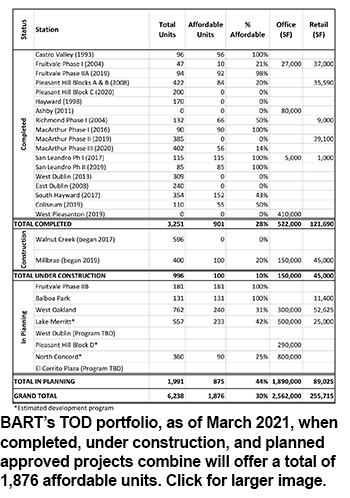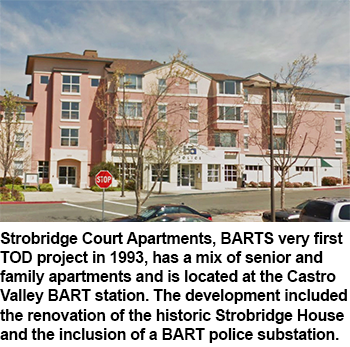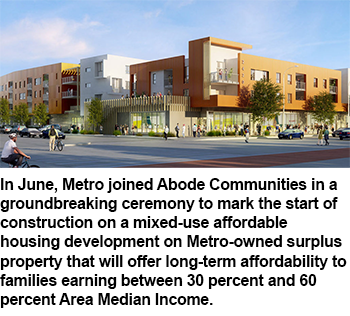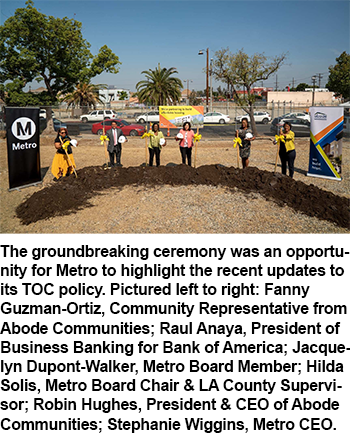Affordable and equitable housing near transit addresses critical housing shortage.
By Stephanie Jordan
Managing Editor
Transit California
At the time of his campaign for Governor, Gavin Newsom promised 3.5 million new housing units by 2025. For reference, over the past decade California has averaged less than 100,000 new homes per year, significantly slower than that of most other states. Despite the Governor's efforts, as housing development actually declined in 2019, “despite a surge in the final two months, the year ended with 110,218 new housing starts, down 7 percent from 2018,” according to the Construction Industry Research Board.
While there is debate over how much new housing is needed in California, (various entities report – using a variety of methodologies – the number to be anywhere between a deficit of 2 million to 1.1 million units) all arrive at the same conclusion — that California has not built near enough housing in the past to keep pace with demand and is not building enough to meet future needs.
Writes the authors of “California’s Housing Future: Challenges and Opportunities” published in February 2018: “As affordability becomes more problematic, people “overpay” for housing, “over-commute” by driving long distances between home and work, and “overcrowd” by sharing space to the point that quality of life is severely impacted. In extreme cases, people can become homeless either visibly on the streets, or less visibly as they experience housing instability and cope with temporary and unstable accommodations.”
Enter TOD 
The lack of housing supply and rising costs are compounding growing inequality and limiting advancement opportunities for many Californians. One of the solutions to increasing affordable housing units is transit-oriented development (TOD). This approach is particularly viable because of density – allowing for more affordable and equitable housing near transit for greater accessibility to job-rich areas, medical appointments, and everyday needs.
Last month the nonprofit advocacy organization TransForm released the report, Measuring the Promise of Transit-Oriented Development, that quantifies the climate and affordability benefits of potential future development at several San Francisco Bay Area Rapid Transit (BART) stations, with wider implications for housing development near transit everywhere. The independent report offers a range of recommendations to BART and other transit agencies with developable land near transit, as well as cities, developers, and advocates.
In its report, TransForm expands upon the collective benefits of hypothetical development scenarios at seven BART stations where new homes are most likely to be built on what are currently surface parking lots. Together, such development would create 4,837 new homes, 2,035 of which would be below market rate. These homes would generate two-thirds less GHG emissions than the regional average and bring 6,900 new daily BART riders to the system. On average, 90 percent of riders would take sustainable modes of transportation to their station, a 14 percent increase from pre-COVID levels.
TransForm advocates this key strategy to ensure new housing reduces emissions and maximizes affordability: Don’t overbuild parking near transit.
“Achieving these benefits for the climate, for low-income families, for transit ridership hinges on limiting replacement parking and providing new alternatives to access stations for those who currently drive alone,” says Darnell Grisby, the Executive Director of TransForm. “Everyone needs a home, not everyone needs a parking space at a BART station.”
While the goals of TOD are worthy, there are those that have concerns that the rezoning required for the developments threatens single-family housing, asserts that TOD residents will still drive cars and park them on city streets, and that most of the developments consist of luxury apartments that actually accelerate gentrification and displacement.
In 2019, Los Angeles City Council member Paul Koretz (D) stated, “We’re building more housing around transit, and demolishing affordable housing to build luxury housing.” Earlier that year, LA City Council voted unanimously to oppose Senate Bill 50 — authored by Democratic state Sen. Scott Wiener — calling for transit development as part of an effort to create millions of new housing units in California citing concern over displacement, gentrification, and offering too many perks in a developers favor.
The new TransForm report discusses the crucial role that cities and other public agencies play to ensure the best outcomes from new housing development near transit. It describes the local policies necessary to preserve existing affordable housing, prevent and mitigate displacement of residents with low incomes, and minimize gentrification. The report is the culmination of a two-year project, funded by a Caltrans Sustainable Transportation Planning Grant, in which TransForm provided technical analysis and community engagement support to BART with a focus on proposed developments at the Lake Merritt and El Cerrito Plaza stations.
BART
BART has a strong history of TOD efforts. The agency partnered with BRIDGE housing in 1993 to build its first TOD project: the Strobridge Court Apartments. The $75 million project included a mix of 96 senior and family one-, two-, three-, and four-bedroom apartments located at the Castro Valley BART station, the renovation of the historic Strobridge House, and a BART police substation. The Metropolitan Transportation Commission conferred its Grand Award upon Strobridge Court, and the project also received the Pacific Coast Builders Conference Gold Nugget “Best in the West” award.
According to the agency, BART has 13 completed projects, four under construction projects, and seven approved projects in the pipeline. BART also owns an estimated 250 acres at 27 stations that could accommodate future development.
Last spring BART Board of Directors voted to amend its Transit-Oriented Development Policy to more strongly support the production of affordable housing. The policy amendments provide greater clarity about the expected financial return to BART from its developments, and allow for a discount of up to 60 percent from fair market value for its land for projects with affordable housing. Projects with a greater share of affordable housing, and serving households with lower incomes, will be eligible for a higher discount.
At that time, the Board noted BART stations are embedded in many communities saying, “we have a chance to make those areas work better for everyone.” The agency wants the public to know that the people behind BART are aware of the difficulties long faced by lower income workers and families struggling to afford to live in the Bay Area, and realizes that COVID-19 has only exacerbated the struggle.
More information on all of BART’s TOD projects and policies is available on the agencies website.
METRO
Like BART, Los Angeles County Metropolitan Transportation Authority (Metro) has increased its focus on TOD in an effort to respond to California’s housing crisis. The Metro Joint Development (JD) Program has generated nearly 2,200 units of housing on Metro property to date, more than one-third is affordable. According to the agency, the number of units will more than double in the next few years bringing more than 1,000 affordable units to the area. 
As housing undersupply, affordability, and homelessness continues to worsen in LA County, the Metro Board asked staff last year to assess what more could be done by Metro to address the issues regionally. After convening an internal working group, a series of roundtables with external stakeholders, and several online surveys to gather public input into the project, in January, the staff drafted a policy that included more than 150 suggestions for changes to the existing policy from Board Directors, community stakeholders, advocates, industry experts and colleagues. From May 7 to June 1 the draft policy, along with survey results, were posted to gather feedback and comments. On June 16, the updated policy was brought to the Board for adoption as a way to better support equitable transit-oriented communities (TOCs).
A groundbreaking ceremony to celebrate the start of construction on a mixed-use affordable housing development on Metro-owned property located near the corner of Cesar E. Chavez Avenue and Soto Street in Boyle Heights took place on June 30. At the event, Los Angeles Mayor and then Metro Board Chair Eric Garcetti joined Los Angeles County Supervisor and Metro’s incoming Board Chair Hilda Solis and other elected officials in praising the project as an example of Metro’s updated Joint Development Policy that enables the agency to build as much quality affordable housing near transit for those who need it most, as soon as possible. 
The project, known as La Veranda, is a $39.9 million modern mixed-use development featuring 76 affordable apartments plus one unrestricted property manager’s apartment and amenity-rich programing with 21,602 square feet of open space. The development features a resident center; multipurpose room; outdoor fitness space with jogging path; play structure; community garden; amphitheater; outdoor courtyards; secured bicycle parking; and 8,000 square feet of community-serving retail.
Declared Los Angeles Mayor and then Metro Board Chair Eric Garcetti at the event, “The Chavez/Soto project is an example of how we can make the intersection of transportation and housing part of the blueprint of our efforts to tackle our housing crunch, create more affordable communities citywide, and forge a future of sustainability for our residents.”
La Veranda’s income-restricted housing will serve families and people experiencing homelessness through a range of one- to three-bedroom units, including 38 apartments that will be offered to households earning less than 20 percent of Area Median Income (AMI). The site totals approximately 1.96 acres of Metro-owned property with the Metro L Line (Gold) Soto Station located a quarter mile south of the site for easy access to the Metro Rail system.
“Transit-oriented development on Metro-owned land near transit stops helps families reduce the two largest household expenses – housing and transportation,” observes Metro CEO Stephanie N. Wiggins. “How we use our land can help make the difference between a thriving community for all versus one that doesn’t work for low- and moderate-income families.”
While Metro does not have land use authority in Los Angeles County (local jurisdictions hold this power), Metro can leverage the land it owns on behalf of the public, usually adjacent or proximate to Metro’s transit infrastructure to deliver transit-supportive uses (to the extent these uses comply with local land use policies).
The updated Metro TOC policy makes it clear that concerns like those stated in 2019 by Los Angeles City Council member Koretz are being addressed. At the groundbreaking event Metro Board Member Jacquelyn Dupont-Walker stated: “Metro must be a partner in all efforts to stabilize communities and avoid displacement. That will happen when we work with stakeholders to ensure a mixture of low-and-moderate-income housing that fits the legacy and historic nature of the neighborhood where housing is being built,” said Jacquelyn Dupont-Walker, Metro Board Member. "A more equitable Los Angeles County is one in which families and individuals can afford to live in good housing near transit without worrying about displacing their neighbors.”
An Affordable Housing Solution
One of the outcomes of the COVID-19 pandemic is a greater awareness of the link between housing, health, and safety. Whether TODs or expansive TOCs, like La Veranda, public transit agencies with available land can play a crucial role in providing more people with stable homes in better connected communities, while still protecting vulnerable residents from displacement.
For decades housing construction in California has not kept pace with the demand, and in particular the need for affordable housing can be seen on the streets in urban and suburban communities alike, as the unhoused’s tents and encampments attest. Could TODs be one answer to the affordable housing shortage? Yes. Transit agencies can – as evidenced by Metro and BART – along with their partners, provide TOD projects that merge land use planning and transit planning to bring equitable access to good housing, jobs, schools, and other community destinations.